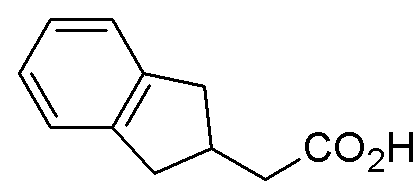2-Indanylacetic acid is widely utilized in research focused on:
- Pharmaceutical Development: This compound serves as a key intermediate in the synthesis of various pharmaceuticals, particularly in the development of anti-inflammatory and analgesic drugs.
- Biochemical Research: It is used in studies investigating metabolic pathways and enzyme activity, helping researchers understand the biochemical processes in living organisms.
- Material Science: The compound is explored for its potential in creating novel materials, particularly in polymer chemistry, where it can enhance material properties.
- Agricultural Chemistry: It finds application in the formulation of plant growth regulators, aiding in the improvement of crop yields and resistance to environmental stress.
- Analytical Chemistry: 2-Indanylacetic acid is employed as a standard in various analytical methods, assisting in the accurate quantification of related compounds in complex mixtures.
General Information
Properties
Safety and Regulations
Applications
2-Indanylacetic acid is widely utilized in research focused on:
- Pharmaceutical Development: This compound serves as a key intermediate in the synthesis of various pharmaceuticals, particularly in the development of anti-inflammatory and analgesic drugs.
- Biochemical Research: It is used in studies investigating metabolic pathways and enzyme activity, helping researchers understand the biochemical processes in living organisms.
- Material Science: The compound is explored for its potential in creating novel materials, particularly in polymer chemistry, where it can enhance material properties.
- Agricultural Chemistry: It finds application in the formulation of plant growth regulators, aiding in the improvement of crop yields and resistance to environmental stress.
- Analytical Chemistry: 2-Indanylacetic acid is employed as a standard in various analytical methods, assisting in the accurate quantification of related compounds in complex mixtures.
Documents
Safety Data Sheets (SDS)
The SDS provides comprehensive safety information on handling, storage, and disposal of the product.
Product Specification (PS)
The PS provides a comprehensive breakdown of the product’s properties, including chemical composition, physical state, purity, and storage requirements. It also details acceptable quality ranges and the product's intended applications.
Certificates of Analysis (COA)
Search for Certificates of Analysis (COA) by entering the products Lot Number. Lot and Batch Numbers can be found on a product’s label following the words ‘Lot’ or ‘Batch’.
*Catalog Number
*Lot Number
Certificates Of Origin (COO)
This COO confirms the country where the product was manufactured, and also details the materials and components used in it and whether it is derived from natural, synthetic, or other specific sources. This certificate may be required for customs, trade, and regulatory compliance.
*Catalog Number
*Lot Number
Safety Data Sheets (SDS)
The SDS provides comprehensive safety information on handling, storage, and disposal of the product.
DownloadProduct Specification (PS)
The PS provides a comprehensive breakdown of the product’s properties, including chemical composition, physical state, purity, and storage requirements. It also details acceptable quality ranges and the product's intended applications.
DownloadCertificates of Analysis (COA)
Search for Certificates of Analysis (COA) by entering the products Lot Number. Lot and Batch Numbers can be found on a product’s label following the words ‘Lot’ or ‘Batch’.
*Catalog Number
*Lot Number
Certificates Of Origin (COO)
This COO confirms the country where the product was manufactured, and also details the materials and components used in it and whether it is derived from natural, synthetic, or other specific sources. This certificate may be required for customs, trade, and regulatory compliance.

